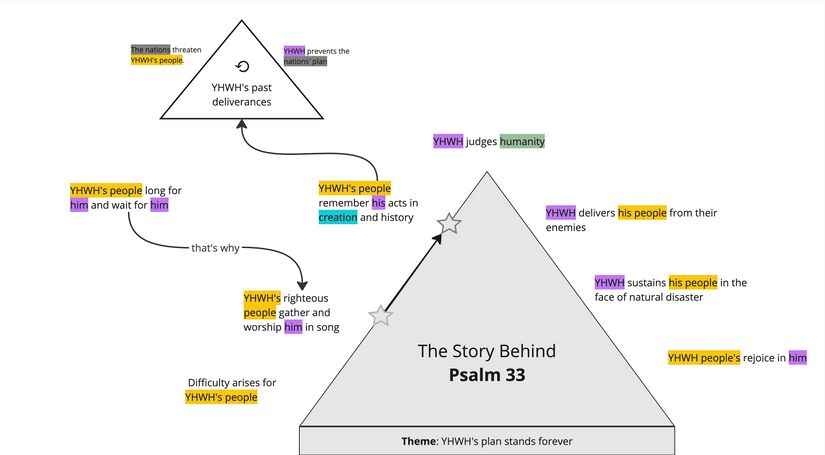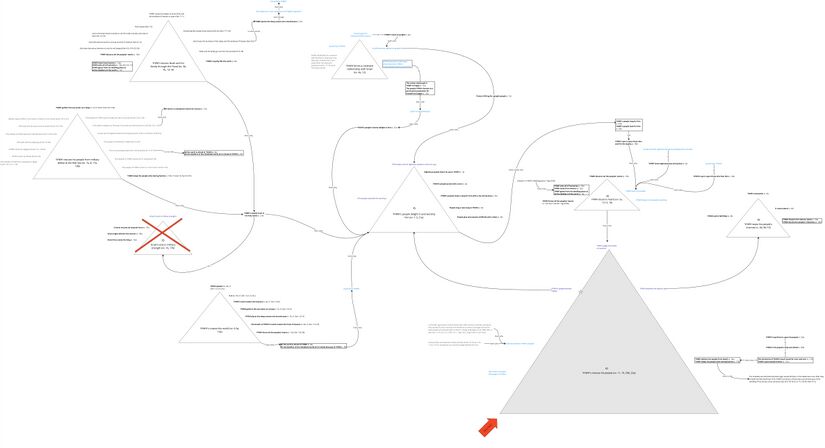Psalm 33 Story behind the Psalm: Difference between revisions
Amanda.Jarus (talk | contribs) (→v. 18) |
Amanda.Jarus (talk | contribs) |
||
| Line 43: | Line 43: | ||
===v. 5=== | ===v. 5=== | ||
<p class='expanded paraphrase' style='display:inline'> | <p class='expanded paraphrase' style='display:inline'> | ||
''Because'' ''' | ''Because'' '''he loves righteousness and justice,''' ''he ensures that this is what fills the earth. When sin fills the earth with violence, he responds with judgment and cleansing, so that, in the end, it’s always true that'' '''the earth is full of YHWH’s loyal-love''' ''not just in loyal-love to his own but also faithfulness to judge the wicked''. | ||
</p> | </p> | ||
| Line 53: | Line 53: | ||
===v. 7=== | ===v. 7=== | ||
<p class='expanded paraphrase' style='display:inline'> | <p class='expanded paraphrase' style='display:inline'> | ||
''At creation, YHWH separated the waters above from the waters below, and he separated the water from dry land. Therefore,'' ''' | ''At creation, YHWH separated the waters above from the waters below, and he separated the water from dry land. Therefore,'' '''he is the one who gathers the sea water as a heap!''' ''Not only did this show his power to create, but the separation of water from dry land was a preview of YHWH's later saving acts for his people: At the Exodus, YHWH piled the water as a heap so that his people could walk through on dry land; and the same thing happened at the crossing of the Jordan. At the crossing of the Red Sea, the enemy Egyptians were destroyed by the collapse of the waters upon them. Therefore, the one who gathers the sea water as a heap is powerful and compassionate to save his people from military threats.YHWH caused the Flood by allowing the spring of the deep oceans to burst forth along with opening the windows of heaven, then stopped the Flood by shutting the deep oceans and the windows of heaven. So, we say that'' '''He is the one who places the deep oceans into storehouses!''' ''His control of the deep oceans saves righteous people like Noah but destroys YHWH's enemies, like the Egyptians.'' | ||
</p> | </p> | ||
Latest revision as of 18:56, 30 April 2025
About the Story Behind Layer
The Story behind the Psalm shows how each part of the psalm fits together into a single coherent whole. Whereas most semantic analysis focuses on discrete parts of a text such as the meaning of a word or phrase, Story Behind the Psalm considers the meaning of larger units of discourse, including the entire psalm. (Click 'Expand' to the right for more information.)
The goal of this layer is to reconstruct and visualise a mental representation of the text as the earliest hearers/readers might have conceptualised it. We start by identifying the propositional content of each clause in the psalm, and then we identify relevant assumptions implied by each of the propositions. During this process, we also identify and analyse metaphorical language (“imagery”). Finally, we try to see how all of the propositions and assumptions fit together to form a coherent mental representation. The main tool we use for structuring the propositions and assumptions is a story triangle, which visualises the rise and fall of tension within a semantic unit. Although story triangles are traditionally used to analyse stories in the literary sense of the word, we use them at this layer to analyse “stories” in the cognitive sense of the word—i.e., a story as a sequence of propositions and assumptions that has tension.
Story Behind Visuals for Psalm 33
Summary Triangle
The story triangle below summarises the story of the whole psalm. We use the same colour scheme as in Participant Analysis. The star icon along the edge of the story-triangle indicates the point of the story in which the psalm itself (as a speech event) takes place. We also include a theme at the bottom of the story. The theme is the main message conveyed by the story-behind.

Background ideas
Following are the common-ground assumptionsCommon-ground assumptions include information shared by the speaker and hearers. In our analysis, we mainly use this category for Biblical/Ancient Near Eastern background. which are the most helpful for making sense of the psalm.
- YHWH used his control over the deeps to send and stop the Flood, which was an instrument of his judgment (Gen 7:11, 8:2).
- YHWH saved his people at the Red Sea by piling up the waters as a heap (Exod 15:8; cf Josh 3:13-16); there he threw Egyptian horses and their riders into the sea (Exod 14:23; 15:1, 19, 21).
- YHWH formed a covenant with his people, and if they keep it then he will be their god (Gen 17:7-8) and they will be his treasured possession (Exod 6:7, 19:6, Deut 29:13).
Background situation
The background situation is the series of events leading up to the time in which the psalm is spoken. These are taken from the story triangle – whatever lies to the left of the star icon.

Expanded paraphrase
The expanded paraphrase seeks to capture the implicit information within the text and make it explicit for readers today. It is based on the CBC translation and uses italic text to provide the most salient background information, presuppositions, entailments, and inferences.
(For more information, click "Expanded Paraphrase Legend" below.)
| Expanded paraphrase legend | |
|---|---|
| Close but Clear (CBC) translation | The CBC, our close but clear translation of the Hebrew, is represented in bold text. |
| Assumptions | Assumptions which provide background information, presuppositions, entailments, and inferences are represented in italics. |

